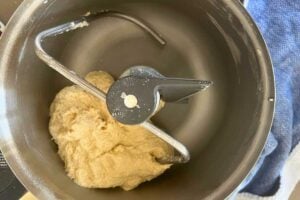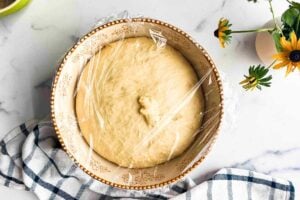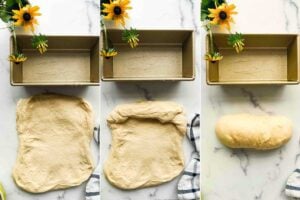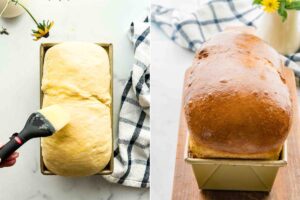Soft Buttermilk Bread
A soft and fluffy sandwich bread with just the right about of sweetness. One of our very favorite loaves.
Equipment
- 9x5 inch loaf pan
- Stand mixer with a dough hook attachment
- Plastic wrap or a clean towel
- Measuring cups and spoons
- Pastry brush
- Instant-read thermometer
- Wire cooling rack
- Nonstick cooking spray or oil (for greasing)
- Clean, damp tea towel
Ingredients
- 3 cups all-purpose flour
- ¾ cup buttermilk (room temperature)
- ¼ cup water
- 2 tablespoons vegetable oil
- 3 tablespoons sugar
- 1 egg
- 1½ teaspoons salt
- 2¼ teaspoons instant or active dry yeast
For brushing the loaf
- 2 tablespoons melted butter
Instructions
- Mix the ingredients. Add the flour, buttermilk, water, vegetable oil, sugar, egg, salt, and yeast in the stand mixer bowl fitted with a dough hook or a large mixing bowl. Mix at low speed (or stir by hand) for 2-3 minutes until dough forms. The dough should come together and not stick to the sides or bottom of the bowl.
- Knead the dough. Knead the dough on medium speed in the mixer (or knead by hand on a lightly floured surface) for 10-15 minutes until the dough is smooth, soft, and elastic. The dough is ready when it passes the “windowpane test”—if you stretch a piece of dough between your fingers, it should become thin and translucent without tearing. If the dough feels dry, add a teaspoon of water until moist but not sticky. If it’s too sticky, sprinkle in a little flour.

- The first rise. Shape the dough into a smooth ball and place it in a clean, lightly oiled bowl. Then, cover the bowl with a clean, damp tea towel or plastic wrap and place it in a warm spot. Let the dough rise for about 60 minutes until it has doubled and looks puffy.

- Shape into a loaf. Lightly grease a 9x5-inch loaf pan with nonstick spray. Turn the risen dough out onto a lightly floured surface. Then, gently stretch the dough into a rectangle, making the shorter side the same length as the longer side of the loaf pan (about 9x18 inches). Next, fold the top edges and start rolling the dough down, keeping it tight. Tuck the ends under and pinch the seam closed. Place the loaf, seam-side down, into the prepared loaf pan.

- The second rise. Cover the loaf with heavily greased plastic wrap or a clean towel. Let it rise in a warm place for 45-60 minutes or until the dough has risen about 1 inch above the edge of the pan. Towards the end of the rising time, preheat your oven to 350°F (175°C).

- Bake. Brush the top of the loaf with melted butter. Bake the loaf in the preheated oven for 35-40 minutes, or until the top is golden brown and the bread sounds hollow when tapped. If you have an instant-read thermometer, the internal temperature should reach 195-200°F (90-93°C).

- Cool. Remove the bread from the oven and carefully turn it from the pan onto a wire rack. Let it cool completely before slicing.
Video
Notes
Whether you’re using quick-rise or traditional yeast, it’s crucial to use it before it goes bad. Yeast gets weaker as it ages; old yeast can stop your bread from puffing upright. Always check the use-by date before you start, and keep your yeast in the fridge or freezer to make it last longer.
If your buttermilk, water, or eggs are too cold, they might slow down the yeast, making your dough rise slower. It’s best to let these ingredients warm up before mixing them in.
You can put baking paper at the bottom to avoid the dough sticking to the pan. This trick helps you get the bread out easily after it’s done, with no mess or sticking.
Putting some melted butter over the top of your bread before and after baking can make it taste better and keep the crust soft. If you like the crust to look shiny, try brushing on some egg wash (mix an egg with a bit of water) instead.
Even though it’s hard to wait, let the bread cool down completely on a rack before you slice it. If you cut it too soon, the inside might be sticky and less light and airy.
This bread recipe is also great for adding different flavors. You can stir in some herbs, seeds, or a bit of grated cheese for something different. Just make sure not to add too much extra stuff that could make the dough heavy.
Nutrition
Calories: 116kcal | Carbohydrates: 25g | Protein: 3g | Fat: 0.3g | Saturated Fat: 0.04g | Polyunsaturated Fat: 0.1g | Monounsaturated Fat: 0.02g | Sodium: 243mg | Potassium: 31mg | Fiber: 1g | Sugar: 3g | Calcium: 4mg | Iron: 1mg
Servings: 12 slices
Calories: 116kcal